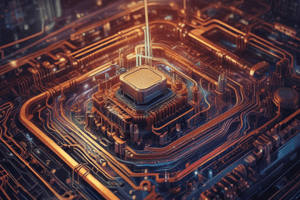Podcast
Questions and Answers
What is the main characteristic of a DIAC?
What is the main characteristic of a DIAC?
- It has three terminals
- It has two gate terminals
- It has a faster turn-off time than an SCR
- It conducts in either direction when properly activated (correct)
What is the breakover voltage used for in a DIAC?
What is the breakover voltage used for in a DIAC?
- To initiate conduction with either polarity (correct)
- To increase the power rating
- To control the current flow
- To turn off the DIAC
What is the main application of a DIAC?
What is the main application of a DIAC?
- Voltage multiplication
- Power supply regulation
- Trigger circuit for the Triac (correct)
- Current amplification
What is a TRIAC?
What is a TRIAC?
What is the characteristic of a TRIAC?
What is the characteristic of a TRIAC?
What is the characteristic of a UJT in the negative resistance region?
What is the characteristic of a UJT in the negative resistance region?
Flashcards are hidden until you start studying
Study Notes
Silicon-Controlled Switch (SCS)
- Similar to SCR, but with two gate terminals (cathode and anode gate)
- Four-terminal thyristor used to trigger the device ON and OFF
- Faster turn-off time than SCR
- Used in counters, registers, and timing circuits
Turning On and Off SCS
- Turn on: Positive pulse on cathode gate or negative pulse on anode gate
- Turn off: Positive pulse on anode gate or negative pulse on cathode gate, or reducing anode current below holding current
DIAC
- Two-terminal four-layer thyristor that conducts in either direction when properly activated
- Requires breakover voltage to initiate conduction with either polarity across the two terminals
- Neither terminal is referred to as cathode
- Contains two anodes, anode 1 and anode 2
DIAC Equivalent Circuit and Basic Operation
- From A1 to A2: Q1 & Q2 forward-biased, Q3 & Q4 reversed-biased
- From A2 to A1: Q3 & Q4 forward-biased, Q1 & Q2 reversed-biased
DIAC Applications
- Trigger circuit for the Triac
- Proximity Sensor circuit
TRIAC
- A bi-directional thyristor used to control power in AC circuits
- A Diac with a gate control or two SCRs in parallel and in opposite directions with a common gate terminal
- Has two leads designated MT1 and MT2 or A1 and A2, and a gate lead used to control conduction
- Can be turned on by a pulse of gate current and does not require breakover voltage to initiate conduction
TRIAC Characteristic Curve
- Current direction depends on the polarity across the terminal
- Turns off when the current drops to a sufficiently low level
- Breakover potential decreases as the gate current increases
UJT (UNIJUNCTION TRANSISTOR)
- A three-terminal semiconductor device with only one pn junction
- A breakover type switching device useful in timers, oscillators, waveform generators, and gate control circuits for SCRs and TRIACs
- Two base leads B1 and B2, and an emitter E lead
- Interbase resistance, RBB, is the resistance of its n-type silicon bar
- Intrinsic standoff ratio, η, is the ratio of RB1 to RB1 + RB2
UJT Operations
- VP = ηVBB + Vpn, where VP is the peak-point voltage
- At peak-point, VE = VP and IE = IP
- Then, VE decreases as IE continues to increase, producing negative resistance characteristic
- At valley point, VE = VV and IE = IV
- Beyond valley point, the device is in saturation, and VE increases very little with increasing IE
Programmable UJT (PUT or PUJT)
- A four-layer pnpn device with a gate connected directly to the sandwiched n-type layer
- RBB, η, and VP can be controlled through RB1 and RB2 (external to the device)
Studying That Suits You
Use AI to generate personalized quizzes and flashcards to suit your learning preferences.





